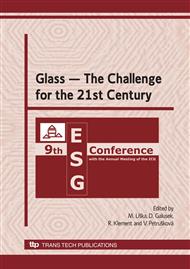p.387
p.391
p.395
p.399
p.405
p.413
p.419
p.425
p.431
Developments in Glass Melting Furnace Design, Energy and Environmental Management
Abstract:
This paper covers the experiences of the authors based on the studies and developments made within the company over the years, where improvements on furnace design have always been a major issue. Developments have been achieved by driving forces like requirements for higher glass quality, different products, and increased number of product changes, energy efficiencies, lower investment cost and environmental challenges. Although in the glass world today there are studies and projects to develop different radical melting techniques, like plasma melting, submerged combustion, segmented melter and vacuum refiners being the most promising among the many, the progress going from pilot to full scale is slow and not all the glass manufacturers are giving enough funds to support these projects. Even though the conventional furnace technology is quite mature and energy performances of the most energy efficient furnaces [1] and pull rates are approaching near to the limits, there are still differences between the energy consumptions, pull rates and life of furnaces in glass industry today. Many small steps can be taken at different areas like optimizing furnace design criteria, refractory selection, use of additional equipments, and development of sensors, better combustion equipment, advanced control systems. These all add to continuous incremental developments for each project and give us opportunity to progress with feedback from onsite applications.
Info:
Periodical:
Pages:
405-412
Citation:
Online since:
April 2008
Authors:
Keywords:
Price:
Сopyright:
© 2008 Trans Tech Publications Ltd. All Rights Reserved
Share:
Citation:


